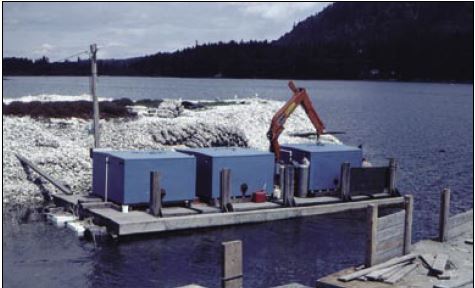6.2.3 Preparations at the remote site
An important consideration for a grower is site selection for the remote setting operation. Of primary concern is water quality and the criteria used in selecting a site for a hatchery apply equally to a remote setting operation. Areas with known sources of pollution need to be avoided.
Salinity must be within an accepted range (greater than 20 PSU for Pacific oysters), the water should be well oxygenated and the temperature close to 20°C or above during summer months to eliminate the need to heat water. Water should be pumped from at least 2 m below the surface to reduce variations in salinity in areas of high rainfall. The water should be phytoplankton rich so that it can be used as a source of food for juveniles and reduce the need for adding food. The site must have electrical power, sufficient space for tanks and other parts of the operation, good communications so that larvae can be readily received, and the site should be close to the intertidal beach area where juveniles will be transferred and held after they are removed from setting tanks.
Tanks are constructed at a grower facility for setting the larvae. There are no set dimensions for the tanks, it depends partly on the type of cultch used, size of the operations, methods used to handle juveniles and individual preference (Figures 85 and 90). Cultch used on the Pacific coast is either old bivalve shell – mostly oyster shell – or grooved plastic pipes of about 2 cm in diameter. Bivalve shell is placed in plastic mesh (“vexar”) bags that are 1 to 2 m in length and 50-70 cm in diameter. Each bag holds 100 to 200 pieces of shell. Grooved plastic pipe is usually cut in 2 m lengths. Smaller tanks may measure 1.5 x 2.5 x 2.5 m in size but may be much larger and hold 40 000 l.

Figure 90: Setting tanks at a site in British Columbia, Canada. Note the loose cultch and vexar bags filled with cultch stacked on the bank behind the tanks. Refer also to Fig. 85, Part 5.4.3.2.
The tanks can be constructed of a variety of materials, including concrete, fibreglass, or fibreglass coated wood. Regardless of the material used, tanks should be well leached before use. In temperate areas the walls of fibreglass tanks are generally insulated with styrofoam to help maintain water temperature. In some instances the tanks are also fitted with a lid to further improve insulation. A 2-cm plastic pipe with holes drilled at regular intervals is placed around the inner circumference of the bottom of the tank and serves as an air line. The water may need to be heated at certain times of the year in temperate regions. A hot water line can be run from the main facility or individual electrical heaters placed in each tank. Tanks should be constructed so they can be readily cleaned and be fitted with drain valves.
The first step when a remote set is planned is to add the cultch to the tanks so that they are as completely filled with settlement material as possible. Vexar bags with bivalve shell are stacked one on top of the other or plastic pipes bundled together in modules. The cultch, whether plastic pipes or old bivalve shell, is generally not conditioned in seawater for a sufficient period of time to acquire a biofilm. Plastic pipes are well leached before use. Shell is generally air dried and exposed to the elements for at least six months before use and then it is washed so that the surfaces are clean.
The amount of cultch required depends on size of the tanks. Generally, between 16 and 20 vexar bags of cultch will occupy about 1 m3. The tanks are filled with seawater filtered to about 50 ?m either through a sand filter or by individual filter bags on each of the tanks. Seawater is heated to the desired temperature which is generally between 20 and 25oC for Pacific oysters.